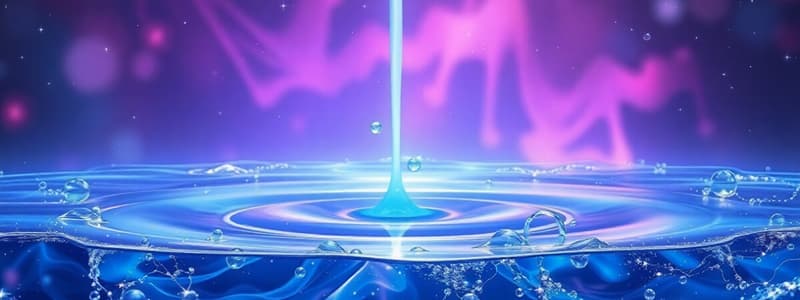Podcast
Questions and Answers
If you dissolve 4.89 g of $NH_3$ in enough water to make 205.1 mL of solution, what is the molarity of the solution?
If you dissolve 4.89 g of $NH_3$ in enough water to make 205.1 mL of solution, what is the molarity of the solution?
- 17.03 M
- 0.2872 M
- 1.40 M (correct)
- 0.2051 M
How does the molality of a solution change if the amount of solvent is doubled, while the amount of solute remains constant?
How does the molality of a solution change if the amount of solvent is doubled, while the amount of solute remains constant?
- The molality doubles.
- The molality quadruples.
- The molality remains the same.
- The molality is halved. (correct)
What is the molality of a solution formed by dissolving 15.0 g of sugar ($C_{12}H_{22}O_{11}$) in 350 mL of water, assuming the density of water is 1.00 g/mL?
What is the molality of a solution formed by dissolving 15.0 g of sugar ($C_{12}H_{22}O_{11}$) in 350 mL of water, assuming the density of water is 1.00 g/mL?
- 0.0428 m
- 0.438 m
- 4.28 m
- 0.125 m (correct)
A 0.500 M stock solution of KCl is available. How many milliliters of this stock solution are needed to make 100.0 mL of 0.100 M KCl solution?
A 0.500 M stock solution of KCl is available. How many milliliters of this stock solution are needed to make 100.0 mL of 0.100 M KCl solution?
A student dilutes 25.0 mL of a 0.881 M sodium hydroxide solution by adding 50.0 mL of water. What is the concentration of the diluted solution?
A student dilutes 25.0 mL of a 0.881 M sodium hydroxide solution by adding 50.0 mL of water. What is the concentration of the diluted solution?
How does an increase in temperature typically affect the viscosity of a liquid, and why?
How does an increase in temperature typically affect the viscosity of a liquid, and why?
Which of the following scenarios best illustrates the concept of surface tension?
Which of the following scenarios best illustrates the concept of surface tension?
Which type of intermolecular force is primarily responsible for the capillary action of water in plants?
Which type of intermolecular force is primarily responsible for the capillary action of water in plants?
A scientist observes that a certain liquid wets a glass surface very effectively. What can be inferred about the adhesive and cohesive forces within the system?
A scientist observes that a certain liquid wets a glass surface very effectively. What can be inferred about the adhesive and cohesive forces within the system?
Consider two liquids: Liquid A has strong hydrogen bonding, and Liquid B has only weak London dispersion forces. Which liquid is expected to have higher surface tension?
Consider two liquids: Liquid A has strong hydrogen bonding, and Liquid B has only weak London dispersion forces. Which liquid is expected to have higher surface tension?
How do Van der Waals forces enable geckos to climb smooth surfaces, and what is the nature of these forces?
How do Van der Waals forces enable geckos to climb smooth surfaces, and what is the nature of these forces?
During condensation, what happens to the enthalpy of a substance, and why?
During condensation, what happens to the enthalpy of a substance, and why?
Which of the following best describes what happens to water molecules during vaporization?
Which of the following best describes what happens to water molecules during vaporization?
Which process describes a substance changing directly from a solid to gas state?
Which process describes a substance changing directly from a solid to gas state?
Water changing into ice is an example of what phase transition?
Water changing into ice is an example of what phase transition?
In a solution, which component is present in a smaller amount?
In a solution, which component is present in a smaller amount?
Which of the following is characteristic of an amorphous solid?
Which of the following is characteristic of an amorphous solid?
Which type of crystalline solid is generally hard and brittle, and an insulator in solid form but a conductor when liquid?
Which type of crystalline solid is generally hard and brittle, and an insulator in solid form but a conductor when liquid?
Which of the following is true of evaporation compared to vaporization?
Which of the following is true of evaporation compared to vaporization?
What remains constant based on the first law of thermodynamics?
What remains constant based on the first law of thermodynamics?
If a solution is described as 'concentrated,' this indicates that it contains:
If a solution is described as 'concentrated,' this indicates that it contains:
What distinguishes crystalline solids from amorphous solids?
What distinguishes crystalline solids from amorphous solids?
A solution is prepared by dissolving 50g of NaCl in 200g of water. What is the percentage concentration by mass of the solution?
A solution is prepared by dissolving 50g of NaCl in 200g of water. What is the percentage concentration by mass of the solution?
A chemist dissolves 20 g of NaOH in enough water to make 500 mL of solution. What is the molarity of the solution? (Molar mass of NaOH = 40 g/mol)
A chemist dissolves 20 g of NaOH in enough water to make 500 mL of solution. What is the molarity of the solution? (Molar mass of NaOH = 40 g/mol)
You need to prepare 250 mL of a 0.2 M solution of KCl. How many grams of KCl are required? (Molar mass of KCl = 74.5 g/mol)
You need to prepare 250 mL of a 0.2 M solution of KCl. How many grams of KCl are required? (Molar mass of KCl = 74.5 g/mol)
How many milliliters of a 0.5 M solution of HCl are needed to have 10 g of HCl? (Molar mass of HCl = 36.5 g/mol)
How many milliliters of a 0.5 M solution of HCl are needed to have 10 g of HCl? (Molar mass of HCl = 36.5 g/mol)
Which action will likely increase the solubility of a solid solute in a liquid solvent?
Which action will likely increase the solubility of a solid solute in a liquid solvent?
Which of the crystalline solid are Malleable and Ductile?
Which of the crystalline solid are Malleable and Ductile?
Flashcards
Viscosity
Viscosity
Resistance of a liquid to flow; related to intermolecular forces.
Surface Tension
Surface Tension
Energy required to expand a liquid's surface, influenced by intermolecular forces.
Intermolecular Force
Intermolecular Force
Attractive forces between molecules; electrostatic in nature.
Cohesive Forces
Cohesive Forces
Signup and view all the flashcards
Adhesive Forces
Adhesive Forces
Signup and view all the flashcards
Capillary Action
Capillary Action
Signup and view all the flashcards
Enthalpy
Enthalpy
Signup and view all the flashcards
Condensation
Condensation
Signup and view all the flashcards
Molality (m)
Molality (m)
Signup and view all the flashcards
Dilution Equation
Dilution Equation
Signup and view all the flashcards
Molarity
Molarity
Signup and view all the flashcards
Dilution
Dilution
Signup and view all the flashcards
Calculating Moles
Calculating Moles
Signup and view all the flashcards
Vaporization
Vaporization
Signup and view all the flashcards
Evaporation
Evaporation
Signup and view all the flashcards
Melting
Melting
Signup and view all the flashcards
Freezing
Freezing
Signup and view all the flashcards
Sublimation
Sublimation
Signup and view all the flashcards
Crystalline Solid
Crystalline Solid
Signup and view all the flashcards
Amorphous Solid
Amorphous Solid
Signup and view all the flashcards
Conductor
Conductor
Signup and view all the flashcards
Insulator
Insulator
Signup and view all the flashcards
Solute
Solute
Signup and view all the flashcards
Solvent
Solvent
Signup and view all the flashcards
Concentrated Solution
Concentrated Solution
Signup and view all the flashcards
Dilute Solution
Dilute Solution
Signup and view all the flashcards
Energy
Energy
Signup and view all the flashcards
Study Notes
- Viscosity is a liquid's resistance to flow freely.
- A liquid's viscosity relates to its intermolecular force, which determines how easily molecules move.
- Larger molecules typically have higher viscosity.
- Viscosity and heat are inversely proportional.
- Viscosity and the strength of intermolecular forces are directly proportional.
- Surface tension is the energy required to expand a liquid surface.
- Liquids with stronger intermolecular forces have higher surface tension.
- Surface tension allows objects with a higher density than water to float on the surface of water.
Intermolecular Forces
- Intermolecular forces mediate interactions between molecules.
- They are electrostatic forces of attraction between molecules in a compound.
- These forces attract molecules, bring them closer, and stabilize the compound.
- Cohesive forces are intermolecular forces between molecules of a liquid, describing the attraction between comparable molecules.
- Adhesive forces describe interactions between a liquid and a solid surface; a liquid clings to the surface it rests on with wetting agents.
- Capillary action moves water molecules against gravity, which is important for plant life.
- Dipole-dipole forces are attractive forces between the positive end of one polar molecule and the negative end of another.
- Ion-dipole forces are attractive forces between an ion and a neutral molecule with a dipole.
- Van der Waals forces are weak intermolecular forces dependent on the distance between atoms or molecules, that arise from interactions between uncharged atoms/molecules.
Phase Changes
- Enthalpy: total heat content of a system, equaling the internal energy plus the product of pressure and volume.
- Condensation: the change of state from gas to liquid, which can be achieved by cooling or saturating the air.
- Vaporization: a phase transition from liquid to vapor, or the physical destruction of an object via intense heating.
Vaporization vs. Evaporation
- Vaporization occurs when a liquid changes to its vapors at its boiling point; evaporation occurs below the boiling point.
- Vaporization happens at a fixed temperature (boiling point); evaporation can occur at various temperatures.
- Temperature remains constant during vaporization but may change during evaporation.
- Vaporization is a fast, violent process; evaporation is slow and silent.
- Vaporization occurs throughout the liquid's mass, whereas evaporation happens only at the surface.
- Melting is the process where a substance changes from solid to liquid, requiring energy transfer.
- Freezing is when a liquid turns into a solid as its temperature drops below its freezing point.
- Sublimation converts a substance directly from solid to gas, skipping the liquid phase.
Solids
- Crystalline solids (true solids) are uniform with long-order arrangements and anisotropic force. Light bounces in these solids, resulting in different light speeds in different directions.
- Amorphous solids (false/pseudo/super-cooled solids) are non-uniform with short-order arrangements and isotropic force. Light passes through these solids, at the same speed in all directions.
Types of Crystalline Solids
- Conductors allow electricity to flow freely, while insulators hinder this flow.
Characteristics of Crystalline Solids
- Ionic solids have high melting points, are hard and brittle, and are insulators in solid form but conductors when liquid.
- Metallic solids have high melting points, are malleable and ductile, and are good conductors.
- Covalent solids have high melting points, are hard, and are poor/semi-conductors.
- Molecular solids have low melting points, are soft, and are insulators.
Solutions
- A solution is a homogeneous mixture of two or more substances.
- A solute is present in a smaller amount in a solution, and its dissolving process is solvation or dissolution.
- A solvent dissolves a solute to form a solution; solvents can be liquids, gases, or solids.
- Concentrated solutions contain large quantities of solute per unit amount of solution, with solute greater than solvent.
- Dilute solutions contain small quantities of solute per unit amount of solution, with solute less than solvent.
- Solubility measures how much solute dissolves in a solvent at a given temperature.
- A saturated solution has a concentration at the solubility limit, while an unsaturated solution is below this limit.
Energy
- Energy is the capacity to do work.
- Kinetic energy is the energy of motion.
- Potential energy is energy at rest.
- The first law of thermodynamics states that energy can neither be created nor destroyed, only transferred. The total energy of the universe is constant.
- Heat is the energy transfer when two samples at different temperatures are in contact. Energy transfers from hotter to colder samples until they reach thermal equilibrium.
- Solution concentration indicates the amount of solute in a given amount of solution or solvent.
- The amount of solute is in the numerator (grams or moles), and the quantity of solvent or solution is in the denominator (mass or volume).
- % Mass = (Mass of Solute / Mass of Solution) x 100
Molarity
- Molarity (M) measures the solute per liter of solution.
- The amount of solute is proportional to the volume, and molarity is the proportional constant.
- Moles = Mass of Solute / Molar Mass of Solute
- Mass of solute = Moles of solute × Molar mass
- Volume = Moles of Solute / Molarity
Molality
- Molality (m) is the number of moles of solute dissolved in 1 kg of solvent.
- m = moles of solute / kilograms of solvent
Dilution
- Concentrated solutions are diluted to a lower concentration by adding more solvent.
- M1V1 = M2V2
Studying That Suits You
Use AI to generate personalized quizzes and flashcards to suit your learning preferences.




